Site pages
Current course
Participants
General
MODULE 1. PRINCIPLES AND TYPES OF CUTTING MECHANISM
MODULE 2. CONSTRUCTION AND ADJUSTMENT OF SHEAR AND...
MODULE 3. CROP HARVESTING MACHINERY
MODULE 4. FORAGE HARVESTING, CHOPPING AND HANLING ...
MODULE 5. THRESHING MECHANICS, TYPES OF THRESHES, ...
MODULE 6. MAIZE HARVESTING AND SHELLING EQUIPMENT
MODULE 7. ROOT CROP HARVESTING EQUIPMENT
MODULE 8. COTTON PICKING AND SUGARCANE HARVESTING ...
MODULE 9. PRINCIPLES OF FRUIT HARVESTING TOOLS AND...
MODULE 10. HORTICULTURAL TOOLS AND GADGETS
MODULE 11. TESTING OF FARM MACHINES, RELATED TEST ...
MODULE 12. SELECTION AND MANAGEMENT OF FARM MACHIN...
LESSON 27. MISCELLANEOUS HORTICULTURAL TOOLS AND EQUIPMENT
Horticultural tools and equipment mostly manually operated of different types for various operations. It is hand operated equipment and operated by human being. They are simple in operation. Working capacity depends on type of tools used. Cost of operation is very nominal mostly used by gardeners. Overall dimensions depend on type of equipment. Beside manually operated machines power operate machines have also been developed for various horticultural operations performed now a days. Some of them are discussed here.
Compost shredders and mixers: It has an inclined hopper lower side of which consists of high speed combing belt. The endless rubber belt is covered with steel teeth and driven by a built-in electric motor or petrol engine. As the belt moves upward through the hopper, its surface combs and shreds the material until it is fine enough to pass out in a thin layer through the opening between the belt and upper end of hopper. The shredded material is thrown out from the machine by the speed of belt and may be delivered into a large heap. Mixing may be achieved by putting the various constituents through the machine together. When the manure compost is ready for application, it can be spread in the field using farmyard spreader.
Elevators and loaders: Elevators and loaders are very important component of fruit production system. It is essential for bulk loading of fruits and vegetables. General-purpose elevators usually consist of a simple conveyor of chain and slats running on a bed, which may be solid, or in the form of a grille. A hopper and cleaning mechanism can be fitted at base. The angle of bed is adjustable depending upon need. These machines have either two pneumatic wheels or four depending upon the size and capacity. Many elevators and loaders are easily adjustable in height at the lower end as well as at the upper end. They are generally operated by a small engine or motor of 1.0-1.5 kW capacity and are mounted on chassis beneath the elevator.
Tree lopping machine: Lopping of tree is highly labour-intensive and difficult task. It is necessary for having good growth of trees and also from an aesthetic point of view. There is high risks involve in doing this job because the man has to climb the large trees and branches. A power tiller mounted tree-lopping machine can alleviate the problems associated with lopping of tall branches of trees. The machine consists of a circular saw as a cutting unit, a flexible shaft as power transmission unit and a GI pipe frame to support the shaft (Fig. 1). Power is taken directly from the engine crankshaft. The machine with an optimum operating speed of 1800 rpm can cut branches up to 5 cm thick at a maximum height of 5.4 m from the ground. The average capacity of machine is 0.393 m2/h, which is higher than manual labour (0.057 m2/h). On an average, the machine can cut 312 numbers of branches in an hour if all the branches are of 40-mm diameter.
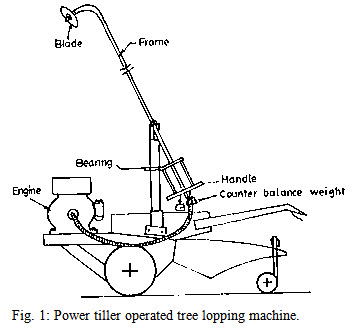
Shelling: There are three steps involved to accomplish the stripping of oil palm fruit lets in the field. The first step is to reduce the strength of fruit-stem joint by applying ethephon on fresh fruit bunch just after harvest. Then prepare threshed materials by producing spike lets from the bunch stalk, and finally detach loose fruit lets from cut spike lets using a drum thresher. The removing of woody shell from coconuts with reasonable protection of meat against damage is tedious job. When meat is to be used for copra then the shell is broken by striking with a large knife either manually or mechanically. However, when meat is to be used for shredding, different kinds of knives or saws are used. Variations in size of coconuts, thickness of shells, curvature of the surface and method of holding the coconut are some of the parameters, which affects the peeling.
A number of machines are available for peeling of coconuts. The first peeler developed consisted of convex and concave cylinders and correspondingly concave-convex cutter and endless band bearing on the surface for paring coconut meats. The second machine developed consisted of a suitable frame and table of revolving curved comb-toothed-radial cutters arranged around and at a distance from the central shaft for support and was driven to remove shells from coconuts. Another machine developed had blades connected with a rotating head for cutting the shell from a coconut. A desirable machine is one that (a) removes the shell from a coconut in a clean-cut and facile manner without injury to the nutmeat and to remove the skin with minimum of waste; and (b) has a duplex cutter mechanisms one for producing a saw-like cut on the coconut from end-to-end at a predetermined depth and other for paring the skin from the nut. The machine is motor-driven, compact, inexpensive and simple to use. It has a provision of disposing of the shell-dust and skin fragments during the operation. In yet another machine, a knife is inserted into an eye of coconut and then it is engaged by a toothed endless chain, the teeth of which penetrates into the shell and move on the knife to remove the shell from meat.
The most of the machines for shelling coconuts involve the use of clamps and employ pressure against the surface to hold the nuts. Whether these clamps were smooth or pronged, many of them are ineffective in holding the nut adequately for smooth shelling. Many of the shelling methods involve complex and expensive equipment requiring constant maintenance. The manner of shelling the nuts includes parallel as well as helical cuts of hard shells, either of which results in inefficient separation of nutmeat and consequently high losses occurs. To minimize the losses, a machine was developed for shelling of whole coconuts. The machine comprises of gripping mechanism to hold the nut rigidly at its ends with grippers that penetrate into shell. The grippers are locked into an axially fixed position and rotated with nuts. Rotary cutter cuts the shell layer-making spiral cut around the central portion of nut while it is in rotation.
Shredding: Large quantities of shredded coconuts are used throughout the world. To prepare it, the shell is clipped from the fresh nut with a sharp axe and the brown cover is shaved off the kernel. It is then washed in water several times, shredded and dried in ovens. It is graded on the basis of fineness of grain and packed for further use. The hand knives are generally used for cutting the kernel or meat from coconuts. The nuts are split in halves and then skilled man cuts the meat from the shell by holding the half in one hand and manipulating the knife with other. This is slow and extremely tiring work and sometimes it becomes necessary to cut the meat into small pieces.
The commonly used mechanical device for shredding large quantities of coconut meat consists of a rotating disc having tangential arranged series of perpendicular comb teeth just above the plane of disc. As the disc rotates, chunks of fresh coconut meat are pressed against it and are squeezed between the comb teeth and the cutting knife to form the coconut shred. This causes a large degree of compression of nutmeat. The coconut shreds are then dried for further use by the consumers.
POST-HOLE DIGGER
The perennial crops require specialized operations like digging and pitting at the time of planting. Pitting is necessary to provide favourable conditions for early establishment and growth of young plants. In the conventional pits, the roots of tree seedlings are unable to penetrate deep into the hard soil and results in uprooting during high-speed winds. In the conventional method, the pits are dug with spade, pick axe etc. which are laborious and time consuming.
Auger digger: It is a high speed machine fitted 1.3 kW single cylinder two stroke engine (Fig. 2). It consists of auger, engine and handle. The weight of equipment is 8 kg, which is easy to handle. For hill region it is efficient equipment for horticulture crops. The auger has length of 680 mm diameter of 60 mm. Capacity is 30 pits/h. It is very efficient equipment for horticultural cultivation.
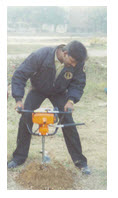
Fig. 2: Auger digger,
The post-hole digger is an implement that drills/digs a hole of varied sizes and depths, which are required for plantation of trees and samplings, fencing, erection of marking stones etc. It can be attached to a 3-point hitch of a tractor. It saves a lot of time as compared to manual digging. It is safer and most economical method of drilling/digging the holes for plantations, nurseries etc. It consists of an auger, which is driven through bevel gears by the tractor PTO. Auger points and leading blades are replaceable.
A soil counter-sinking attachment to the tractor-operated post-hole digger can be used for making conical pits. The soil counter-sinking attachment is fitted on co-operating auger of the post-hole digger (Fig. 3). It includes a sleeve to which three ties of equal lengths are attached. The inner wall portion of sleeve is so designed that it just engages the outer wall portion of co-operating auger of the post-hole digger. Three soil cutting blades extending in the upward direction are welded with three equally spaced ties. The struts made of MS angle hold these ties. The whole assembly is then coupled to the propelling shaft of post-hole digger. The post-hole digger fitted with counter-sinking attachment is placed in a vertical position in the soil and drive is given through PTO shaft. The auger portion makes a cylindrical hole and counter-sinking attachment enlarges the hole in the form of an inverted truncated cone. The pits so made are suitable for planting and growing coconut palms and rubber. The auger gets drive from the tractor PTO through a propeller shaft and bevel gear box. The perpendicularity of digging auger is maintained with four-bar linkage formed by hitching system the tie rod provided at the top. The tip of the auger is either diamond shaped or pointed with wings to suit to different soil conditions. The diameter and depth of hole can be changed by changing the auger assembly.
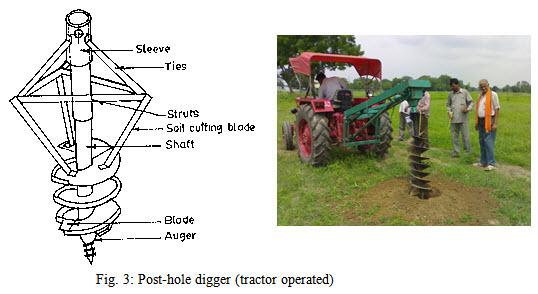
A power tiller operated auger digger can also be used to dig the holes for planting tree-seedlings. The machine consists of a spiral auger actuated by a rack and pinion arrangement (Fig. 4). The auger can be moved up and down with the help of a rotating hand wheel. The drive for circular motion of auger is affected through belt and pulley and bevel gear transmission from engine directly. The entire assembly can be mounted on a rectangular frame. The hand wheel provided at the side of unit can be used for depth control. It can be used where tractor cannot be used. Power tiller operated auger digger consists of a small frame with the provision to lower and raise the soil-working element. Drive is provided to the unit with the help of a set of bevel gears and belt pulleys. Lowering and raising is accomplished by means of a rack and pinion arrangement which is operated by a hand wheel. It has two depth adjustment wheels, which support the weight of the implement, and provides stability. Pits can be dug up to a depth of 45 to 60 cm and the diameter of the posthole is 30 cm. For operation the auger is mounted on a power tiller and is lowered with the help of a steering. The auger is lifted when the desired depth of the hole is achieved. The machine can dig 35-40 holes/h.
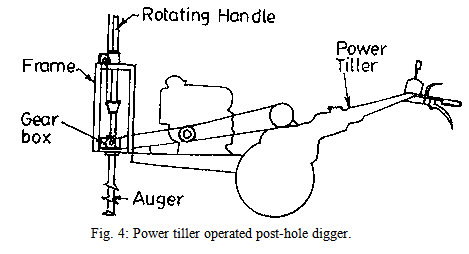
Tractor mounted banana Stem shredder
Banana is a major cash crop of the country, cultivated on 4.4 lakh hectares. Out of the total of about 10.4 million tonnes produced, the state of Maharashtra alone accounts for 63,000 ha under this crop. In India about 20 cultivars viz., Dwarf Carvendish, Rabusta, Monthan, Proven, Nandran, Red banana, Nyali, Safed Vekhi, Basarao, Ardhapuri etc are cultivated. Banana is mostly check row planted with the spacing varying from 125 x 125 to 150x150 cm, depending upon the variety. Plant population is about 4,500 per ha. After the harvest of the banana bunch, the stem is manually cut and left in the rows. After the harvest of the whole field, these are collected and left near the boundary for drying and subsequent burning. This process is tedious and time consuming. The banana stem shredder helps in disposing of the stem immediately after harvest. Shredded material is suitable for mulching in the banana garden and also for vermi compost. The average diameter of banana stem is 225 mm at the bottom and 100 mm at the top with the average height of 2400 mm. The banana stem consists of 95% of water and only 5% of fiber.
The shredding unit consisted of 4 blades placed perpendicular to each other at 225 cm distance. Additionally, 12 nos. of spikes with flat cutting edge are fitted with a gap of 120 mm between the rows. The whole device is mounted on a frame made of MS angle. The blades are driven by the PTO of the tractor with a bevel gear box and the hopper is trapezoidal in shape with a height of 800 mm. The stem is cut into small pieces and the water and fibre are separated. During field trials it takes 1.2 minutes to shred the stem having average height of 2400 mm (Fig. 5). About 52 stems are required for shredding in one hour. The shredded material can be used for mulching in the banana garden. The shredded material takes 3-4 days to dry. The shredded fibre can be used for preparing vermi compost.
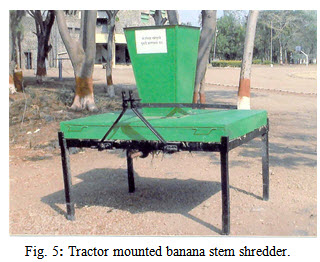
Plant shredder for vermi compost
Vermi compost is a major ingredient in organic cultivation prepared from animal dung or biogas slurry. Though cattle population is increasing still there is shortage of dung as it is mainly used by farmers for cooking stove thereby reducing its availability for vermi compost. There is several biomass weeds material grown in nature rich in NPK content but not being used for productive purposes. A plant shredder is an effective machine for shredding of biomass weeds into small pieces which can supplement dung to prepare vermi compost. A plant shredder (Fig. 6) was tested in shredding of two weeds biomass i.e. Casia tora and Lantana camera and mixed with cow dung in 60:40 and 40:60 proportion and vermi compost was prepared with time treatment of 45 and 60 days. The weed biomass was shredded by shredder in 2 to 4 cm pieces with output of 175 kg/h. The vermi compost was prepared and its NPK was determined using standard procedure. The result showed that after 60 days of time vermi compost with 40 percent cow dung and 60 percent biomass weed gave significantly higher NPK content over control treatment of vermi compost with plain cow dung.
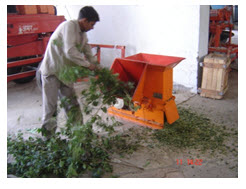 Fig. 6: Operation of plant shredder.
Fig. 6: Operation of plant shredder.
Tractor mounted banana clump remover
Banana crop is maintained for two years to get the benefit of two harvests. The crop needs removal of clumps (plants along with root portion) after two years. During the process of removal of the clump, the entire mother plant along with the rhyzome and side suckers as a whole mass has to be removed so as to prepare the land for the next crop. Manual labourers using crowbars and spades do this operation. The labourers have to dig to a depth of up to 450 mm to remove the clumps and hence the operation is cumbersome.
In view of above, a tractor operated banana clump remover was developed at TNAU, Coimbatore to mechanize the clump removing operation and to reduce human drudgery involved. The nine-tyne cultivator frame has been adopted for the development of the equipment. Two numbers of 100 x 15 x 1000 mm sub-soiler shanks with shares of size 190 x 40 x 5 mm are fitted in the nine tyne cultivator frame at 225 mm spacing. These two sub- soilers perform as a fork while removing the banana clump. A deflector has been provided to push the soil sideways. The equipment is attached to the 3-point linkage of a 26 kW tractor. For removal of banana clump the sub soiler shank is positioned behind it, and pressed into soil with the hydraulic system and the tractor is gently moved forward, simultaneously lifting the sub-soiler (Fig. 7). This combined action removes the entire clump along with its root portion as a whole mass. The field capacity of machine is 0.5 ha/h.
